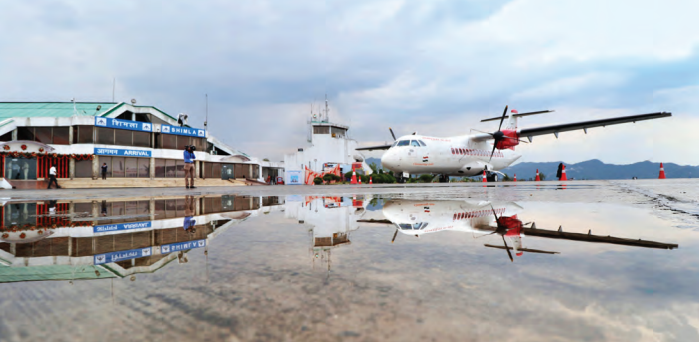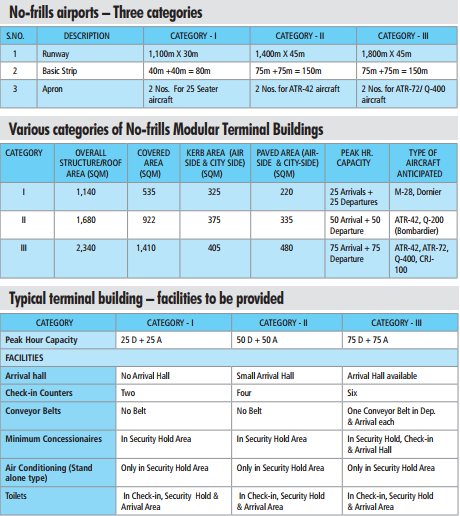No-Frills Airports
AIBM
October - December 2017
In line with its policy to make flying affordable for more people, the Indian government has developed a policy to promote low-cost or no-frills airports to complement the low-cost carriers.
Currently, fewer than three pc of India’s 1.3 billion people fly and the Government of India along with Airports Authority of India (AAI) are taking concrete steps to make flying affordable to more people in the nation. The government has taken several measures, including the regional connectivity scheme Ude Desh Ka Aam Naagrik (UDAN) connecting un-served and under-served airports/cities.
While airlines account for a large part of the cost of an air ticket, few people realise that airports, too, play their part in making the tickets expensive or less expensive, as the case might be. For instance, the User Development Fee and other airport charges and taxes could account for as much as 30 pc of a ticket, at least on certain short and medium haul flights on low cost tickets.
The airport charges are indeed the reason that even when airlines launch a promotional fare of say INR 1 or 99, the customer ends up paying at least INR 1,000 or 1,500, which goes towards airport development charges and taxes.
Doing away with frills
With a view to reduce the burden on the airlines and hence the passengers, the government has decided to create no-frills airports in order to make their use and therefore air-travel, more economic. The no-frills airports would limit or avoid costs of services and activities that are not necessarily crucial for airport operations and that would allow the costs to be kept at the lowest possible level.
These costs are mainly related to landing fees, parking fees, security and civic amenities at the airports. All of these costs would be lower at the no-frills airports. It would start with the terminal buildings themselves.
The no-frill airports terminals will be without the expensive glass and steel, with fancy lounges, centralised air conditioning, aerobridges, conveyor belts as well as escalators and elevators for the passengers. In some ways, they would take us to that nostalgic period of a few decades ago, when passengers walked to the aircraft from a single-storey building with minimum interference.
By doing away with such frills, the airports would be able to drastically cut their capital costs as well as operational costs and the resultant reduction in the interest burden, one of the major headaches of most of the large airports in the country and around the world. This will also help boost tourism and make it commercially viable for airlines with smaller aircraft.
The only thing that would be similar to other airports would be security and safety and the central government expects all components of the government to contribute to the effort of keeping costs at the lowest possible levels for these airports. For instance, state governments are expected to provide land free of cost and other encumbrances, but only as much as is needed for the essential operations.
These airports would be operational only during the day time and in fair weather, doing away with the need of expensive advanced landing systems at airports. Though in hilly regions, airports would have visual guidance through Airfield Lighting. The control towers at these airports could be mobile or a fixed, simple pre-engineered structure.
These airports would be of three categories, scaling up as per the passenger traffic. The buildings would be modular to allow for expansion at a relatively low cost. The buildings would take about six months to make as opposed to the two years or more it takes for a normal terminal building.
Besides the navigation system, AAI will also provide training to the state’s fire services and rescue teams and besides this, the airports would be equipped with ambulance and medical services as well as security and anti-hijacking measures such as X-rays, explosives and ammunition detection systems, and personnel scanners. The airport would also have two sets of walkie-talkies for communication and of course a Very High Frequency (VHF) system for the Control Tower.
The terminal buildings have been put in three categories depending on the number of passengers to be handled in peak hours, ranging from as low as 50 passengers per hour in the peak hours up to 150 in an hour. The space allocated per passenger in terms of built up area of the terminal building has been cut from 25 sqm in normal airports to 10 sqm at no-frills airports. Air conditioning of security hold area and lounges will be standalone, allowing airport operators to shut off lighting and air conditioning in areas that are not under use at any given moment. Only larger airports, handling 150 passengers per hour would have conveyor belts and most of the infrastructure at these airports would be such that it could actually be shifted to another location if it becomes redundant at any airport. Such stripped down, flexible and modular airports are indeed the need of the hour if India is to get an airport close to every Indian’s house or work place as is the mission of the government.
PR Team, AAI











